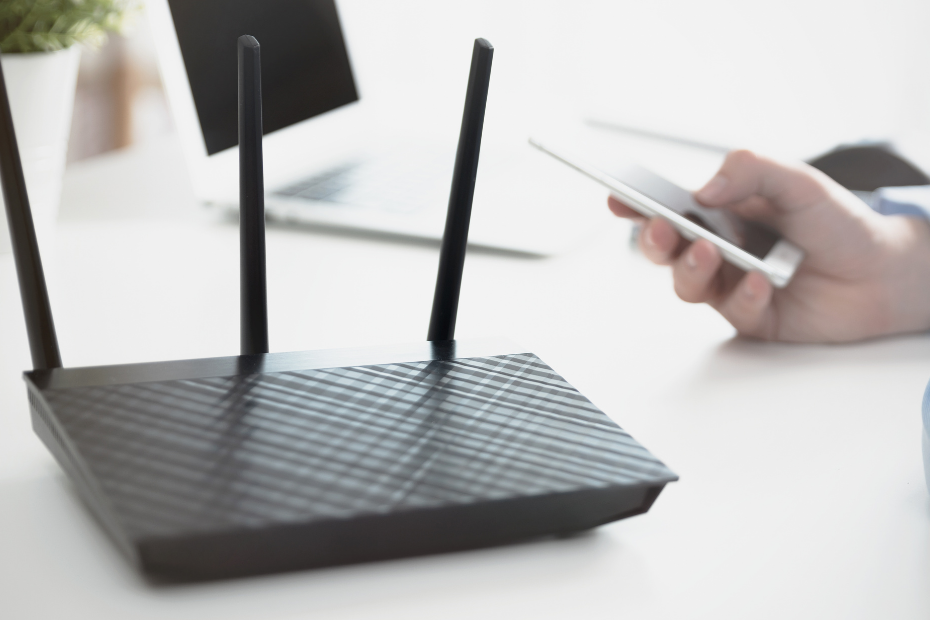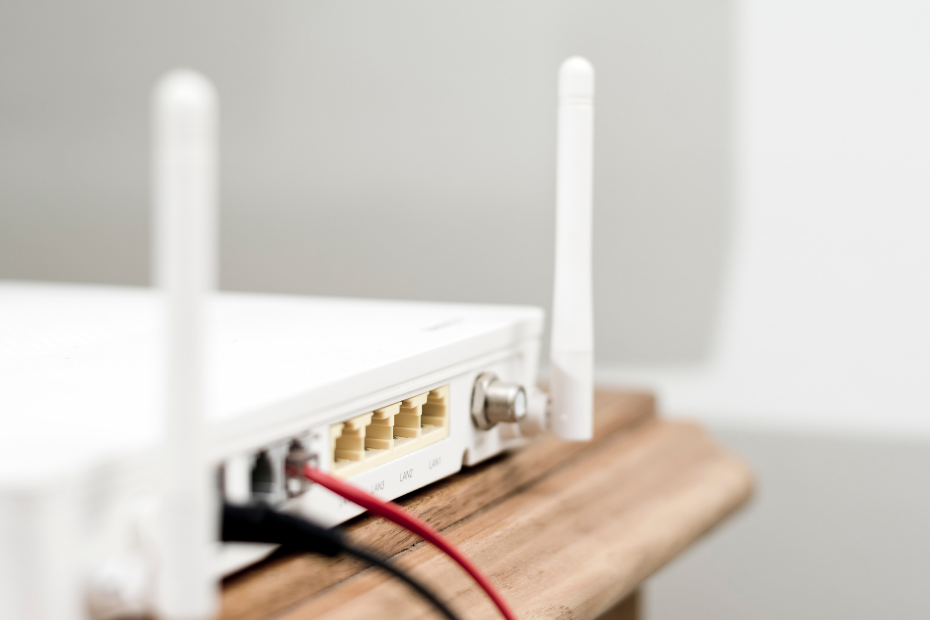These days, wireless routers come in either 2.4 GHz, 5 GHz, or dual-band models. Although all three essentially do the same thing, there are some key differences that can make or break your experience when surfing the internet at home. Depending on your needs, one Wi-Fi frequency band may be significantly better than the other, but what exactly is the difference between the two? And which one should you choose for your home or office?
What is a Dual Band Router?
In simple terms, a dual-band router is a router that supports both the 2.4 GHz and 5 GHz frequency bands. If you have a newer model router, you may have noticed that when you set it up, there were multiple Wi-Fi network options for you to choose from; this is because the router is asking you if you want to connect using 2.4 GHz or 5 GHz. There are times when you’ll probably want to use 2.4 GHz, and other times when 5 GHz will be the better option.
In order to understand when each frequency band is best, it’s important to first understand the main differences between the two, so let’s look at that now.

What is the difference between 2.4 GHz and 5 GHz wireless frequencies?
There are three main differences between 2.4 GHz Wi-Fi and 5 GHz Wi-Fi, the speed (& bandwidth,) the network coverage, and the amount of interference penetration. The speed determines how fast your internet responds to requests. Network coverage refers to the range from which you can access your internet services, and interference penetration refers to how much signal degradation your Wi-Fi can overcome without it adversely affecting your browsing experience. Let’s briefly go over each of these considerations so that you can get a better idea of when to select each frequency.
Speed & Bandwidth
Without a doubt, the newer 5 GHz Wi-Fi band is much faster than the older 2.4 GHz Wi-Fi, but that doesn’t necessarily mean that it’s always better. 5 GHz networks are also able to support many more devices at the same time compared with the slower 2.4 GHz frequency, which quickly gets bogged down when multiple devices are connected to the network. If your main concern is speed, then go with 5 GHz, as it is noticeably faster; you would be at a big disadvantage if you tried to game competitively on a 2.4GHz Wi-Fi connection.
Coverage
On the other hand, if speed is less of a concern and coverage is more important to you, then 2.4GHz Wi-Fi is the way to go. Although 5 GHz Wi-Fi is newer, it can’t reach as far as the older 2.4 GHz frequency band can reach. So, suppose you are setting up Wi-Fi for an office or business environment and need to ensure that the entire facility has internet coverage. In that case, it might be smart to use a 2.4GHz network, as you may find that 5GHz connections have performance issues the further you get from the router.
Interference
The final significant difference between 2.4GHz and 5Ghz Wi-Fi is the amount of interference each type of connection can penetrate. Electronic interference can occur due to a number of reasons, such as the presence of other electronics near your router, steel doors and walls between your device and the router, or other networks running in close proximity to your network. That said, the biggest cause of interference comes from other devices operating on the same frequency band.
Ultimately, interference means that your signal is being degraded due to something affecting its range. The newer 5 GHz Wi-Fi band is much better at penetrating interference, meaning that you are more likely to get a great internet connection with 5 GHz if you have a lot of interference in your home or office; this may change over time as many newer devices start running on 5 GHz, but for the time being the majority of devices are still running on 2.4 GHz making 5G much less susceptible to signal degradation.

Choosing between the two Wi-Fi frequency bands
There are certain instances when one of the two frequency bands will work much better than the other, and there are also times when it doesn’t really matter which Wi-Fi connection you choose. In order to help you make the best decision, let’s go over some of the things that you should consider when deciding which Wi-Fi band to connect with so that you always have reliable internet regardless of where you’re located in your home.
Choosing the Best Option for Your Home
Depending on a number of factors, it may well be the case that one of the two Wi-Fi frequency bands will always be better for you, or it could be the case that a dual-band router may be the best overall option so that you have the freedom to select which network you want to connect with. Let’s go over some of the main considerations when selecting a Wi-Fi frequency band.
Size of Your Home
The size of your home is one of the biggest and most important considerations when choosing which Wi-Fi band you want to use. If you have a large home, then it could very well be the case that the older 2.4 GHz Wi-Fi is much better for you. With 2.4 GHz Wi-Fi, you’ll be able to ensure that you have reliable internet coverage throughout your entire home, whereas with 5 GHz, this may not necessarily be the case.
However, keep in mind that if you choose to enjoy the benefits of 2.4 GHz Wi-Fi, it will come at a cost; your internet will be much slower than it otherwise could have been on a 5 GHz network connection.
Likewise, if you have a smaller home, an apartment, or a condo, then 5 GHz Wi-Fi will almost certainly be the much better option for you. Because your home is not really large, there is no need to sacrifice speed and performance for range, which means that 5 GHz will likely cover your whole home while delivering blazing fast speeds, with less lag and better overall performance compared with a 2.4GHz Wi-Fi connection.
Interferences and Obstacles
2.4 GHz Wi-Fi is more susceptible to network interference which can slow speeds and reduce the overall performance of your network. This is because many more devices use 2.4GHz, including microwaves, Bluetooth devices, garage door openers, and other older routers within range of your network. All of these devices eat away at your signal quality and can cause an otherwise fast internet connection to become slow and unresponsive.
On the other hand, 5 GHz Wi-Fi is less prone to interference because fewer devices are operating on this frequency band. If you elect to go with a 5 GHz connection, then just make sure that your devices are relatively near the router, and you should have no problem getting close to the true speed of your internet service in most, if not all, situations.
Conclusion & Recommendation
There are a few major differences between 2.4 GHz and 5 GHz Wi-Fi connections. 2.4 GHz Wi-Fi has more range than the newer 5 GHz frequency band, making it ideal for office spaces or larger homes where 5 GHz Wi-Fi might not be able to provide total coverage. Conversely, 5 GHz Wi-Fi is well suited to smaller spaces; it provides faster speeds than 2.4 GHz Wi-Fi can accommodate and is far less vulnerable to interference from nearby electronics and other devices running on the network. So, what’s the best option?
In almost all cases, the newer 5 GHz frequency will be the better option; these days, people have many devices and require faster speeds than used to be the case. That said, for business applications, 2.4 GHz Wi-Fi may still be your best bet due to its extended reach. A great middle-ground is to get a network extender for your 5 GHz Wi-Fi, allowing you to enjoy the best of both worlds by extending the range of your 5 GHz Wi-Fi while still providing rapid speed and protection against interference.
At the end of the day, why not get a dual-band router that will allow you to choose which network you want to connect with, depending on what you need to do that day. When you want to maximize your speed and are near the router, you can select 5 GHz, but if you are way on the other side of your house or office, you can connect with 2.4 GHz so that you still have reliable network coverage.



